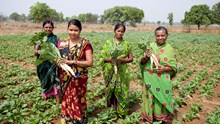
Dragon fruit, also known as Kamalam or pitaya, is emerging as a profitable crop for Indian farmers. Its high market value, low water requirement, and minimal maintenance make it especially suitable for arid and semi-arid regions. Once planted, the cactus-like plant can continue producing fruit for nearly 20 years, making it a sustainable source of income for farmers.
Why Dragon Fruit Farming?
Dragon fruit requires less water and grows well in poor soil, making it ideal for areas facing water scarcity. Compared to traditional seasonal crops that demand replanting and intensive labor, dragon fruit is a perennial plant that yields multiple harvests annually. Its high demand in domestic and international markets adds to its appeal. This combination of low maintenance and high returns makes it a smart investment for progressive farmers.
Government Support and Subsidies
Recognizing its potential, both central and state governments have launched several initiatives to promote dragon fruit cultivation:
-
National Expansion Target: Under the Mission for Integrated Development of Horticulture (MIDH), the Centre plans to expand cultivation from 3,000 hectares to 50,000 hectares over the next five years. This includes support for infrastructure, training, and planting materials.
-
State-Level Subsidies:
-
Uttarakhand: Under the proposed ‘Mission Dragon Fruit’, farmers in the Terai region can receive up to 80% subsidy on cultivation costs.
-
Bihar: Offers a 40% subsidy under the National Horticulture Mission to promote dragon fruit farming across suitable districts.
-
Gujarat: Provides assistance up to Rs 4.5 lakh per hectare, with enhanced support for SC/ST farmers.
-
Other States like Maharashtra, Andhra Pradesh, and Haryana are also encouraging cultivation through training, research support, and subsidies.
Farmers interested in obtaining subsidies and training should reach out to their State Horticulture Department or their District Horticulture Officer (DHO). Local Krishi Vigyan Kendras (KVKs) can also provide technical guidance and information about available schemes.
Additionally, information on central-level support under the Mission for Integrated Development of Horticulture (MIDH) is available on the National Horticulture Board (NHB) website: http://nhb.gov.in.
Market Access and Research Support
To ensure better pricing and market reach, dragon fruit has been listed on the e-NAM (electronic National Agriculture Market) platform. Farmers can now sell their produce digitally across the country, ensuring transparency and competitive rates.
Research bodies like ICAR are actively supporting the crop through agronomic research, pest management techniques, and post-harvest processing workshops. This helps farmers maximize productivity and value.
Dragon Fruit Farming Success
Six years ago, Akbar Ali Ahmed from Chirang, Assam, shifted from traditional farming to dragon fruit cultivation. With an investment of Rs 14–15 lakh per hectare, he set up “Khidmat Agro Nursery & Farm” on 2 hectares. Today, his farm earns over Rs 1 crore annually and employs 20+ locals. Akbar also trains fellow farmers, promoting sustainable agriculture in his region.
Read Full Story: Assam Farmer Earns Over Rs 1 Crore Annually with Dragon Fruit Farming, Promotes Sustainable Agriculture
Dragon fruit farming offers a promising opportunity for Indian farmers, particularly in areas with challenging climatic conditions. With strong government support, including financial subsidies, training programs, and initiatives to improve market access, farmers can diversify their crops and increase their income sustainably.















